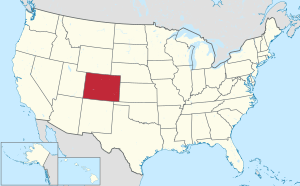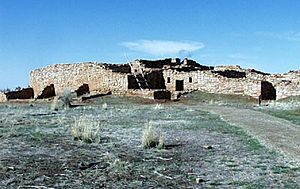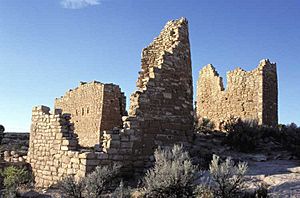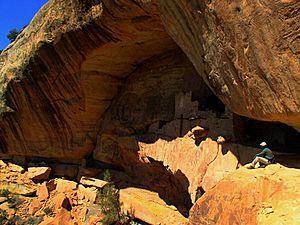The Ancestral Puebloans were ancient people who lived in the southwestern United States. They built amazing homes and villages, often right into the sides of cliffs or on top of mesas. This article is about the different types of homes they built and where you can find some of these ancient sites in Colorado.
Time Periods of the Pueblo People
Archaeologists, who are like history detectives, have divided the time when Pueblo people lived in southwestern Colorado into three main periods:
- Pueblo I Era (750 to 900 AD): During this time, Pueblo buildings were often made of stone. They were usually built facing south and shaped like U's, E's, or L's. These homes were closer together than in earlier times, showing that people were living in bigger communities. People also started building towers, often near special underground rooms called kivas. No one is quite sure why they built these towers – maybe for defense, storage, or ceremonies! Pottery became more common and colorful, with white pots decorated with black designs. People also learned how to manage water better, using reservoirs and dams.
- Pueblo II Era (900 to 1150 AD): The number of people grew a lot during this period, and more than 10,000 new sites were created! Because the land was often dry, people hunted, gathered wild foods, and traded to make sure they had enough to eat. By the end of this period, many homes were made of stone and had multiple stories. Towers were still built, especially in Colorado and Utah. Families and communities also had their own kivas.
- Pueblo III Era (1150 to 1300 AD): This was a time of big changes. People started moving into larger community centers, often built at the ends of canyons or under huge cliff overhangs. The population reached its highest point between 1200 and 1250, with over 20,000 people living in the Mesa Verde region. However, by 1300, most Pueblo people had left the Four Corners area. This was likely because of changes in the climate and not enough food. They probably moved south and east to new villages in Arizona and New Mexico, especially near what are now Santa Fe and Albuquerque.
Kinds of Ancient Buildings
The Pueblo people built unique structures for living, worship, defense, and storing food. Here are some of the main types:
- Pueblo - This word refers to both a style of building and the groups of people themselves. A pueblo building is usually one or more stories tall. It's made from stone or adobe (a mix of mud and straw). Sometimes, they used a style called jacal. These buildings were often covered with adobe plaster inside and out.
- Kiva - These are circular, underground buildings. They were used for ceremonies, preparing for ceremonies, and as warm places for families during cold winters. Kivas might have developed from earlier pit houses. You can find them all over the Ancestral Pueblo area. They usually have a bench around the inside walls, posts to hold up the roof, a fire pit, and a special shaft to bring fresh air to the fire. People entered kivas through a square opening in the roof using a ladder. A family's kiva was often built in front of their living rooms.
- Great houses - These were very large stone buildings covered in adobe plaster. Most archaeologists believe they were used mainly for ceremonies, but some might have also been homes. During the Chacoan period (around 900 to 1150 AD), these buildings had large rooms (about 15 feet square) and were built very big and tall. They often had special kivas built inside them or nearby. Later, in the Pueblo III period (1150-1300 AD), ceremonial buildings looked more like regular homes and often had enclosed plazas.
- Great kivas - These are much larger versions of the regular "family" kivas. They were meant for use by the whole community, especially during Chacoan times. Some great kivas, like Casa Rinconada in Chaco Canyon, were as big as 75 feet across! Their roofs were held up by huge posts set into the floor. In earlier times, some great kivas might not have had roofs.
- Pit houses - In the earliest Pueblo periods, most people lived in pit houses. These were carefully dug rectangular or circular holes in the ground. Their walls were made of branches and mud, supported by strong corner posts. While pit houses were always around, after the Pueblo I period, most people lived in above-ground pueblo rooms, usually with a kiva nearby.
- Cliff dwellings - These are pueblos built under natural overhangs in the sides of cliffs. Cliff dwellings became popular later in Pueblo history (mostly after 1150 AD). Many experts believe they were built partly for defense, as they were hard to reach.
- Trincheras - These unique sites were used by other ancient cultures in the Southwest. Trincheras sites are usually found on steep hillsides. They have terraces and walls that look like steps going up the slope. Early explorers thought these terraces looked like "trincheras," which is Spanish for trenches or fortifications.
- Jacal - This is a type of wall used in Pueblo buildings. It's made by weaving reeds and sticks together and then covering them with adobe. Thin, closely placed poles were tied together and then filled in with mud, clay, and grass.
Places to Explore
| Site name |
Nearest town |
Type |
What makes it special |
Photo |
| Chimney Rock |
Chimney Rock |
Great house |
This site was home to about 200 rooms around 1,000 years ago. People lived, worked, and held ceremonies here. You can take guided tours between May and September. |
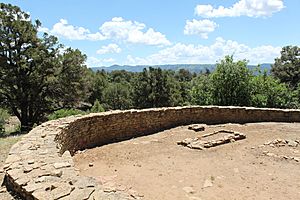
Great Kiva at Chimney Rock, Colorado
|
| Site name |
Nearest town |
Type |
What makes it special |
Photo |
| Ansel Hall |
Cahone |
|
This pueblo village was a good-sized community, especially around 1125 AD. It had great kivas and great houses. It might have been left by 1100 AD. |
|
| Brewer Archaeological District |
Dove Creek |
|
This area has two large ancient settlements: Brewer Mesa Pueblo (from the 11th century) and Brewer Canyon Pueblo (from the 13th century). |
|
| Champagne Springs (Greenlee) Ruins |
Squaw Point, south of Dove Creek |
|
These ruins are on two low hilltops. They show how people lived during the late Pueblo I and early Pueblo II periods. |
|
| Site name |
Nearest town |
Type |
What makes it special |
Photo |
| Darkmold Site |
Durango |
|
This site was used from about 220 BC to 750 AD. Archaeologists found special slab-lined pits and bell-shaped pits here. |
|
| Durango Rock Shelters Archeology Site |
Durango |
|
Also known as Fall Creek Rock Shelters, this site was inhabited between 1 AD and 1000 AD. |
|
| Spring Creek Archeological District |
Bayfield |
|
This area was lived in from 300 BC through the Pueblo periods. Later, the Ute, Apache, and Navajo peoples also lived here. |
|
| Talus Village |
Durango |
|
This site has ancient pit-house dwellings. It was first explored by archaeologist Earl Morris in 1940. |
|
| Ute Mountain Ute Tribe |
Red Mesa |
|
This historic district is on the Ute Mountain Ute Tribe reservation. Pueblo people lived here from about 500 to 1300 AD. |
|
Anasazi Heritage Center
| Site name |
Nearest town |
Type |
What makes it special |
Photo |
| Escalante |
Dolores |
Great house |
Escalante Pueblo was built around 1120-1130 AD. It has stone-walled rooms for families and communities, including kivas. Its style is similar to the famous Chaco Canyon in New Mexico. |
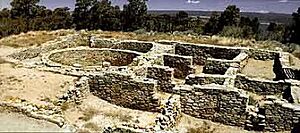
Escalante Pueblo at the Anasazi Heritage Center
|
| Dominguez |
Dolores |
Great house |
Dominguez Pueblo shows how independent family homes looked outside the main pueblo. Archaeologists found many interesting items here, like turquoise beads, shell pendants, and ceramic pots. |

Dominguez Pueblo at the Anasazi Heritage Center
|
Canyons of the Ancients
| Site name |
Nearest town |
Type |
What makes it special |
Photo |
| Sand Canyon |
Dolores |
|
This was one of the largest pueblos in the 13th century, built between 1250 and 1280. It had at least 420 rooms, 90 kivas, and 14 towers. A spring ran through the middle of this walled village, which could hold up to 725 people. People started leaving by 1280, and the pueblo was empty by 1290. |
|
| Castle Rock Pueblo |
Dolores |
Great house |
This pueblo was lived in from 1250 to 1275 AD. It had Great Houses, at least 16 kivas, 40 surface rooms, and nine possible towers. |
|
| Lowry Pueblo |
Pleasant View |
|
Lowry Pueblo was active from 1080 to 1150 AD. It had Great Houses, Great kivas, and roads. It includes 8 kivas, a large community kiva, and 40 rooms, some as tall as three stories. The underground great kiva had murals painted on its walls. It's thought Lowry Pueblo was a local center for religious gatherings. |
|
Hawkins Preserve
| Site name |
Nearest town |
Type |
What makes it special |
Photo |
| Hawkins Pueblo |
Cortez |
|
Hawkins Pueblo is the largest ruin in the preserve. It was most populated between 1000 and 1150 AD. You can find ruins of room blocks, a kiva, mounds, and middens (ancient trash heaps) here. |
|
Hovenweep National Monument
The Hovenweep National Monument is a special place with many ancient ruins.
| Site name |
Nearest town |
Type |
What makes it special |
Photo |
| Cajon Group |
Between Cortez, CO and Blanding, UT |
|
This group of buildings is at the head of Allen Canyon. It includes homes and the remains of a tower, which might have housed 80-100 people. There are also kiva depressions and signs of ancient farming terraces. |
|
| Cutthroat Castle Group |
Between Cortez, CO and Blanding, UT |
|
Cutthroat Castle is the largest ruin in this group. It's unique because it doesn't have a spring nearby, and many of its buildings are below the canyon rim. |
|
| Goodman Point |
Between Cortez, CO and Blanding, UT |
|
Goodman Point is the largest and easternmost village at Hovenweep. It has many pueblo buildings, some partly underground. It was most populated between 1150-1300 AD. |
|
| Hackberry and Horseshoe group |
Between Cortez, CO and Blanding, UT |
|
Hackberry was a medium-sized village, possibly home to 250-350 people. Nearby, the Horseshoe group has four pueblo buildings shaped like a U. Horseshoe Ruin had a dam to create a water reservoir. The buildings were built with "precisely fit" stones. |
|
| Holly Group |
Between Cortez, CO and Blanding, UT |
|
The Holly group is famous for a rock art panel that seems to mark the summer solstice (the longest day of the year). The site has five named buildings: Curved Wall House, Great House, Holly Tower, Isolated Boulder House, and Tilted Tower. |
|
| Hovenweep Castle |
Between Cortez, CO and Blanding, UT |
|
|
|
| Hovenweep House |
Between Cortez, CO and Blanding, UT |
|
|
|
| Rim Rock House |
Between Cortez, CO and Blanding, UT |
|
|
|
| Stronghold House |
Between Cortez, CO and Blanding, UT |
|
|
|
| Square Tower |
Between Cortez, CO and Blanding, UT |
|
The Square Tower group is the largest collection of buildings at Hovenweep, with up to 500 people living there. Towers here came in many shapes (D-shapes, squares, ovals, circles) and were used for different things, like work areas, kivas, homes, and storage. The slots and doors of Hovenweep Castle in this group act like a solar calendar, letting light shine through openings in special patterns during the solstices and equinoxes. |
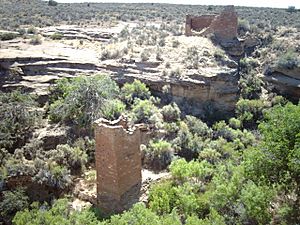
Square Tower at Hovenweep
|
| Twin Towers |
Between Cortez, CO and Blanding, UT |
|
|
|
McElmo Drainage Unit
This area has many ancient sites, including tributaries of McElmo Creek, north of Mesa Verde.
| Site name |
Nearest town |
Type |
What makes it special |
Photo |
| Albert Porter Pueblo |
Yellow Jacket |
Great house |
This was a small Pueblo village. You can learn more about it at the Crow Canyon Archaeological Center. |
|
| Unnamed (Site ID 5MT4700) |
Yellow Jacket |
|
This site from the Mesa Verde culture was occupied between 1200 and 1250 AD. |
|
| Bass site |
Yellow Jacket |
|
This site had Great Houses and was active from 1080 to 1150 AD, with its busiest time around 1125. |
|
| Cannonball Ruins |
Cortez |
|
Cannonball Ruins was a large settlement occupied from 1140 to 1300 AD. Its buildings are similar to those at Hovenweep. It was first explored by Sylvanus Morley in 1908. |
|
| James A. Lancaster Site |
Pleasant View |
|
Also called Clawson Ruins, this site shows evidence of Pueblo people living here for a long time, from 1 AD to 1300 AD. |
|
| Joe Ben Wheat Site Complex |
Yellow Jacket |
|
These ruins date from about 1075 to 1300 AD. It's a large site with 90 rooms and 14 kivas. |
|
| Mitchell Springs Archeological Site |
Cortez |
|
Also known as the Mitchell Springs Ruin Group, this site was active from 500 to 1000 AD. It has ruins of 9 medium-sized pueblos, with a total of 300 rooms, 35 kivas, and towers. Up to 1,000 people might have lived here. |
|
| Mud Springs Pueblo |
Cortez |
|
Also called Toltec Springs, this pueblo was occupied from 1200 to 1250 AD. It had reservoirs and buildings with strong double or triple walls. |
|
| Pigge Site |
Pleasant View |
|
This site was active from 1175 to 1225 AD and had ancient roads. Pueblo people lived here until about 1300 AD. |
|
| Roy's Ruin |
Cortez |
|
Roy's Ruin was occupied in the early 13th century. It's a classic example of a "Prudden Unit," a small site with a tower, kiva, and midden (trash pile). |
|
| Seven Towers Pueblo |
Yellow Jacket |
|
These ruins from about 1150-1300 AD are part of the Northern San Juan pueblo culture. |
|
| Wallace Ruin |
Cortez |
|
Wallace Ruin was a Northern San Juan and Chaco pueblo. People lived here from about 1000 to 1300 AD. |
|
| Woods Canyon Pueblo |
Yellow Jacket |
Great house |
Also known as Wood Canyon Ruin, this pueblo was inhabited from about 1000 to 1300 AD. It has ruins of up to 200 rooms, 50 kivas, and 16 towers. |
|
| Yellow Jacket Pueblo |
Yellow Jacket |
Great house |
Yellowjacket pueblo was lived in during two main periods: 1075-1150 AD and 1175-1250 AD. It had Great Houses, Great kivas, reservoirs, and roads. This huge village covered 100 acres and had at least 195 kivas, 19 towers, and up to 1,200 surface rooms. You can learn more at the Crow Canyon Archaeological Center. |
|
Mesa Verde
Mesa Verde National Park is a very famous place to see Ancestral Puebloan cliff dwellings.
| Site name |
Nearest town |
Type |
What makes it special |
Photo |
| Balcony House |
Cortez |
Great house |
This ruin is on a high ledge. It has 45 rooms and 2 kivas. To enter, visitors climb a 32-foot ladder and crawl through a 12-foot tunnel. This made it easy to defend! One log found here was dated to 1278 AD, meaning it was built just before people left the area. You can visit Balcony House with a park ranger. |

A Navajo man at a T-shaped doorway at Balcony House (1929)
|
| Cliff Palace |
Cortez |
|
This is the largest and most famous cliff dwelling in Mesa Verde. It's built inside a huge cave and faces south, which helped keep it warm in winter. It had 217 rooms, including storage areas, open courtyards, and 23 kivas. Many rooms were brightly painted. |
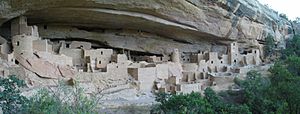
Cliff Palace at Mesa Verde
|
| Fire Temple |
Cortez |
|
|
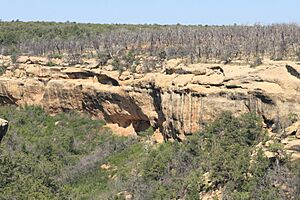
Fire Temple and New Fire House at Mesa Verde National Park
|
| Long House |
Cortez |
Cliff dwellings |
Located on Wetherill Mesa, Long House is the second largest village, home to about 150 people. It has 150 rooms, but they are not as neatly clustered as other cliff dwellings. A spring is nearby, and water seeps into the back of the village. |
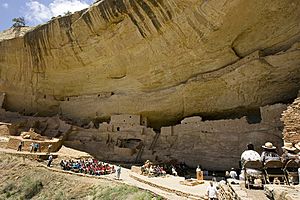
Long House cliff dwellings at Mesa Verde
|
| Mesa Verde Reservoirs |
Cortez |
|
These ancient reservoirs, built by the Ancestral Puebloans, are recognized as a National Civil Engineering Historic Landmark. |

Far View Reservoir at Mesa Verde
|
| Mug House |
Cortez |
|
This ruin on Wetherill Mesa was explored by archaeologist Arthur Rohn. It has 94 rooms on four levels, including a large kiva. This kiva has a special keyhole shape, which is a common feature of the Mesa Verde style. |
|
| Oak Tree House |
Cortez |
|
You can visit Oak Tree House and the nearby Fire Temple on a ranger-guided hike. |
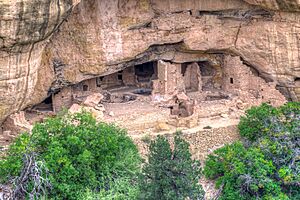
Oak Tree House at Mesa Verde
|
| Spruce Tree House |
Cortez |
|
Spruce Tree House is the third largest village, with 130 rooms and 8 kivas. It's very well preserved because of its protected location. A short trail from the Chapin Mesa Archeological Museum leads to it. |
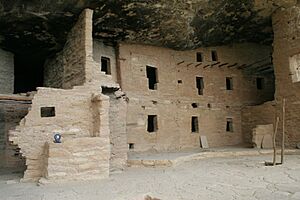
Spruce Tree House at Mesa Verde National Park
|
| Square Tower House |
Cortez |
|
The Square Tower House is a stop on the Mesa Top Loop Road tour. The tower that gives this site its name is the tallest structure in Mesa Verde. People lived in this cliff dwelling between 1200 and 1300 AD. |
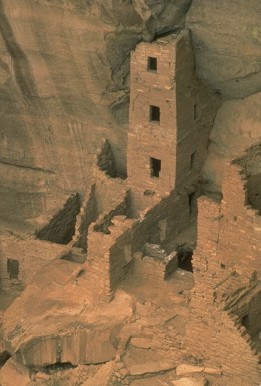
Square Tower House at Mesa Verde
|
Towaoc area
| Site name |
Nearest town |
Type |
What makes it special |
Photo |
| Cowboy Wash |
Towaoc |
|
This site dates from about 1150 to 1175 AD and is on the south slopes of Ute Mountain. Some archaeologists think people from Chaco Canyon might have settled here. |
|
| Ute Mountain Ute Tribe |
Towaoc |
|
The Ute Mountain Ute Mancos Canyon Historic District is on the Ute Mountain Ute Tribe reservation. It was added to the National Register of Historic Places in 1972. |
|
| Yucca House |
Towaoc |
Pueblo village |
Yucca House was lived in during two periods: 1080-1150 AD and 1225-1275 AD. It had Great kivas and Great Houses. The Western Complex was a huge pueblo with up to 600 rooms and 100 kivas. A spring runs through it. The Lower House is an L-shaped pueblo with a plaza, 8 rooms, and a large kiva. |

Yucca House National Monument
|
Other Sites
These sites are sorted by the nearest town.
| Site name |
Nearest town |
Type |
What makes it special |
Photo |
| O'Brien Site |
Dolores |
|
These ruins date from 1075 to 1150 AD. |
|
| Bement Site |
Mancos |
|
This site shows two periods of Pueblo life. First, there was one shelter between 750-850 AD. Later, six structures were lived in from 1000 to 1150 AD. |
|
| Lost Canyon Archeological District |
Mancos |
|
These ruins from 1050-1300 AD (or earlier) are from the Mesa Verde culture. |
|
| Puzzle House |
Pleasant View |
|
Puzzle House was occupied three times: first around 650 AD, and then twice between 1075-1225 AD. |
|
| Shields Pueblo |
|
|
Ruins found in southwestern Colorado. |
|
| Site name |
Nearest town |
Type |
What makes it special |
Photo |
| Dolores Cave |
Uravan |
|
This rock shelter has corn dated to 1500 AD, which suggests some ancient Pueblo people might have stayed in the area and farmed corn. |
|
| Tabeguache Pueblo |
Nucla |
|
Tabeguache Pueblo is an example of an early, spread-out Ancestral Pueblo settlement. It was lived in around 1100 AD before being left. |
|
| Tabeguache Cave II |
Uravan |
|
This is a large prehistoric rock shelter that was used from about 600 to 1500 AD. There are other similar rock shelters nearby. |
|
Images for kids
See also
- Bibliography of Colorado
- Geography of Colorado
- History of Colorado
- Index of Colorado-related articles
- List of Colorado-related lists
- List of prehistoric sites in Colorado
- Outline of Colorado
- Trail of the Ancients


